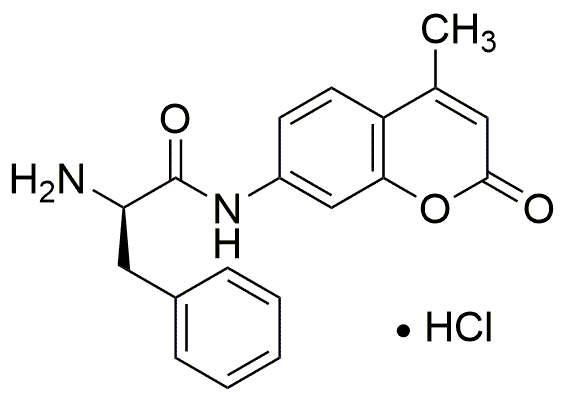H-D-Phe-AMC hydrochloride is widely utilized in research focused on:
- Fluorescent Probes: This compound serves as a substrate for studying protease activity due to its fluorescent properties, making it invaluable in biochemical assays.
- Drug Development: It is used in the screening of potential drug candidates, particularly in the development of inhibitors that target specific enzymes, aiding pharmaceutical research.
- Cellular Imaging: The compound's fluorescent characteristics allow for real-time imaging of cellular processes, providing insights into cellular functions and disease mechanisms.
- Biotechnology: In the field of biotechnology, it is employed in the design of biosensors that detect specific biomolecules, enhancing diagnostic capabilities.
- Research on Protein Interactions: It plays a crucial role in studying protein-protein interactions, helping researchers understand complex biological systems and pathways.
General Information
Properties
Safety and Regulations
Applications
H-D-Phe-AMC hydrochloride is widely utilized in research focused on:
- Fluorescent Probes: This compound serves as a substrate for studying protease activity due to its fluorescent properties, making it invaluable in biochemical assays.
- Drug Development: It is used in the screening of potential drug candidates, particularly in the development of inhibitors that target specific enzymes, aiding pharmaceutical research.
- Cellular Imaging: The compound's fluorescent characteristics allow for real-time imaging of cellular processes, providing insights into cellular functions and disease mechanisms.
- Biotechnology: In the field of biotechnology, it is employed in the design of biosensors that detect specific biomolecules, enhancing diagnostic capabilities.
- Research on Protein Interactions: It plays a crucial role in studying protein-protein interactions, helping researchers understand complex biological systems and pathways.
Documents
Safety Data Sheets (SDS)
The SDS provides comprehensive safety information on handling, storage, and disposal of the product.
Product Specification (PS)
The PS provides a comprehensive breakdown of the product’s properties, including chemical composition, physical state, purity, and storage requirements. It also details acceptable quality ranges and the product's intended applications.
Certificates of Analysis (COA)
Search for Certificates of Analysis (COA) by entering the products Lot Number. Lot and Batch Numbers can be found on a product’s label following the words ‘Lot’ or ‘Batch’.
*Catalog Number
*Lot Number
Certificates Of Origin (COO)
This COO confirms the country where the product was manufactured, and also details the materials and components used in it and whether it is derived from natural, synthetic, or other specific sources. This certificate may be required for customs, trade, and regulatory compliance.
*Catalog Number
*Lot Number
Safety Data Sheets (SDS)
The SDS provides comprehensive safety information on handling, storage, and disposal of the product.
DownloadProduct Specification (PS)
The PS provides a comprehensive breakdown of the product’s properties, including chemical composition, physical state, purity, and storage requirements. It also details acceptable quality ranges and the product's intended applications.
DownloadCertificates of Analysis (COA)
Search for Certificates of Analysis (COA) by entering the products Lot Number. Lot and Batch Numbers can be found on a product’s label following the words ‘Lot’ or ‘Batch’.
*Catalog Number
*Lot Number
Certificates Of Origin (COO)
This COO confirms the country where the product was manufactured, and also details the materials and components used in it and whether it is derived from natural, synthetic, or other specific sources. This certificate may be required for customs, trade, and regulatory compliance.


